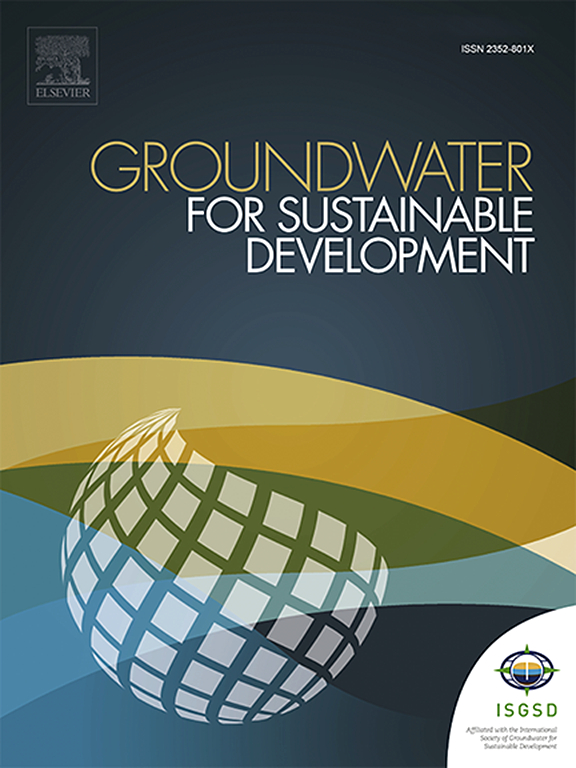An ensemble machine learning approach for predicting groundwater storage for sustainable management of water resources
IF 4.9
Q2 ENGINEERING, ENVIRONMENTAL
引用次数: 0
Abstract
Predicting groundwater storage (GWS) is essential for sustainable water resource management, especially in regions with water scarcity. This study proposes an ensemble machine learning (EML) approach (i.e., Bagging, XGBoost, and CatBoost) leveraging the Landsat-derived parameters to forecast GWS due to the limited availability of field observations. This modeling framework captures complex relationships between socioeconomic and environmental variables and groundwater storage in Chittagong City. Multiple indices, including the normalized difference vegetation index (NDVI), normalized difference built-up index (NDBI), modified normalized difference water index (MNDWI), and urban heat island (UHI), were utilized in the models. A digital elevation model (DEM), nighttime light (NTL), and nearest distance to water bodies from streamline data were used to investigate their impact on GWS. The empirical Bayesian kriging (EBK) method was used to downscale the GWS and NTL data. The outputs of the models were evaluated using statistical indicators such as the coefficient of determination (R2), root mean square error (RMSE), and Willmott's indicator of agreement (WIA). The Bagging and CatBoost models had higher R2 and lower RMSE values (R2 > 0.965, RMSE <1.604 mm) during the summer, while the XGBoost and CatBoost models performed better (R2 > 0.966, RMSE <1.686 mm) in the winter. The results demonstrated that the utilization of Landsat metrics had the potential to serve as the predictive factors for estimating GWS. The proposed modeling framework can be used to predict GWS in regions with limited data, which will help policymakers, urban planners, and environmental organizations develop sustainable groundwater management strategies.

一种用于水资源可持续管理的预测地下水储量的集成机器学习方法
预测地下水储存量(GWS)对于可持续水资源管理至关重要,特别是在缺水地区。由于现场观测的可用性有限,本研究提出了一种集成机器学习(EML)方法(即Bagging、XGBoost和CatBoost),利用landsat衍生的参数来预测GWS。该建模框架捕捉了吉大港市社会经济和环境变量与地下水储存之间的复杂关系。模型采用归一化植被指数(NDVI)、归一化建筑指数(NDBI)、修正归一化水指数(MNDWI)和城市热岛指数(UHI)等多种指数。利用数字高程模型(DEM)、夜间光照(NTL)和流线数据中离水体最近的距离来研究它们对GWS的影响。采用经验贝叶斯克里格(EBK)方法对GWS和NTL数据进行了缩减。采用决定系数(R2)、均方根误差(RMSE)和Willmott’s indicator of agreement (WIA)等统计指标对模型的输出进行评价。Bagging和CatBoost模型R2较高,RMSE值较低(R2 >;0.965, RMSE <1.604 mm),而XGBoost和CatBoost模型表现较好(R2 >;0.966, RMSE <1.686 mm)。结果表明,利用Landsat指标有可能作为估算GWS的预测因子。该模型框架可用于数据有限地区的GWS预测,有助于决策者、城市规划者和环境组织制定可持续的地下水管理策略。
本文章由计算机程序翻译,如有差异,请以英文原文为准。
求助全文
约1分钟内获得全文
求助全文
来源期刊

Groundwater for Sustainable Development
Social Sciences-Geography, Planning and Development
CiteScore
11.50
自引率
10.20%
发文量
152
期刊介绍:
Groundwater for Sustainable Development is directed to different stakeholders and professionals, including government and non-governmental organizations, international funding agencies, universities, public water institutions, public health and other public/private sector professionals, and other relevant institutions. It is aimed at professionals, academics and students in the fields of disciplines such as: groundwater and its connection to surface hydrology and environment, soil sciences, engineering, ecology, microbiology, atmospheric sciences, analytical chemistry, hydro-engineering, water technology, environmental ethics, economics, public health, policy, as well as social sciences, legal disciplines, or any other area connected with water issues. The objectives of this journal are to facilitate: • The improvement of effective and sustainable management of water resources across the globe. • The improvement of human access to groundwater resources in adequate quantity and good quality. • The meeting of the increasing demand for drinking and irrigation water needed for food security to contribute to a social and economically sound human development. • The creation of a global inter- and multidisciplinary platform and forum to improve our understanding of groundwater resources and to advocate their effective and sustainable management and protection against contamination. • Interdisciplinary information exchange and to stimulate scientific research in the fields of groundwater related sciences and social and health sciences required to achieve the United Nations Millennium Development Goals for sustainable development.
 求助内容:
求助内容: 应助结果提醒方式:
应助结果提醒方式:


